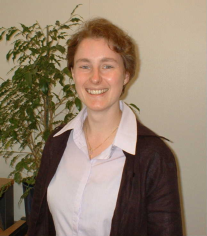Single molecule detection on the cell membrane with near-field scanning optical microscopy
Promotion date: 19 March 2004
| I developed and built a microscope for researching the nanostructure of cell membranes. Cell membranes are complicated structures of lipid bilayer interspersed with special molecules, for instance signal or binding molecules, determining the function of the cell. It is very difficult to image the various molecular components of the cell membrane, as it is such a minute structure. In confocal microscopy (lens-based fluorescence microscopy with a diffraction-limited resolution) you don’t get a spot size smaller than 300 nanometres, which is relatively big considering the size of molecules. |
What was your thesis about?
I developed and built a microscope for researching the nanostructure of cell membranes. Cell membranes are complicated structures of lipid bilayer interspersed with special molecules, for instance signal or binding molecules, determining the function of the cell. It is very difficult to image the various molecular components of the cell membrane, as it is such a minute structure. In confocal microscopy (lens-based fluorescence microscopy with a diffraction-limited resolution) you don’t get a spot size smaller than 300 nanometres, which is relatively big considering the size of molecules. It also has the disadvantage that the light penetrates the cell, which interferes with a clear image of the cell membrane and makes identification of individual membrane molecules extremely difficult. In electron microscopy on the other hand, it is possible to look at smaller structures, but no measuring of living cells is possible; you can only look at dead cells. That is why we wanted to develop a high-resolution microscope using the principle of fluorescence. To image one particular membrane component, we specifically bind the molecule of interest to a fluorescent molecule which lights up when illuminated. We have a close collaboration with biological groups like the department of Tumor Immunology in Nijmegen, a group that is very interested in the spatial organization of membrane molecules on immune cells. They did the fluorescent labelling of specific adhesion molecules that we made visible with our new microscope. In near-field scanning optical microscopy, we use a tiny needle (a pointed optical fibre) of 70 nanometres. The spot of light is the same size as the needle opening and the intensity of the light reduces strongly with the distance from the needle. Thus, we achieved exactly what we set out to do: high resolution and a low background from the cell interior.
Where did you get the idea?
In our group, near-field microscopy has been in use for a long time, we are one of the worlds leading groups in this field. The underlying principles of single molecule fluorescence have been researched before with near-field microscopy. This microscope is specifically developed for the detailed study of cells and combines the two principles of confocal and near-field microscopy so you can look at the overall picture and the cell structure in its smallest detail.
You say you built it, does that mean that you did the actual construction?
Yes, we started with an empty table and now this microscope is here. Of course, there are many components that you can buy, but we integrated the different technologies involved and optimized them for our needs. This is what makes this microscope unique.
And it performs well?
Yes, we discovered a lot about the spatial organization of molecules on the cell surface and because our collaboration with the Tumor Immunology group of Carl Figdor has been so successful, other collaborations with biological groups in Hungary and Italy have been initiated.
In actually building a microscope your research involved a lot of practical work?
It did, and that is exactly what I liked so much, the combination of theory and practice, resulting in a working device and new insights in cell biology.
This microscope might be the very thing other research institutes are waiting for.
How do you communicate it is there?
At conferences for instance. Even in the early stages of my research, I have had the luck to be invited to give a talk on a biophysics conference in München, Germany based on an abstract I wrote on this project. At that stage, I could only image a cell and nothing more. Later I went to a big conference in Boston, USA and had a poster presentation there, showing real quantitative information of molecular domains on a cell membrane. That was a great success, people were very enthusiastic and I learned a lot. This resulted in an invited talk in Buenos Aires, Argentina, I really enjoyed that.
Can your microscope be produced commercially and replace ordinary microscopes in hospital laboratories?
Not really. The technology is still very difficult and it requires understanding of the technology to operate it. It requires a lot of research still to make it work by simply pressing a button or two. Besides, we make our fibre tips by hand; the batch fabrication of these tips is still some way off. But the work on this facet of near-field microscopy continues.
What are you going to do now?
I am first going to write some articles on this subject and then I am going to look for a job.
I would like to continue in a research environment, I am very much attracted to biophysics, I am fascinated by its multidisciplinary character and both its practical (‘real life’) and technological aspects.
Do you want to stay in the Netherlands?
Not specifically. There are many universities, research institutes and companies both in and outside Europe doing very interesting, multidisciplinary research. I will be looking for a combination of an interesting job and a good perspective to further develop myself.
For the summary of the thesis, click here.

